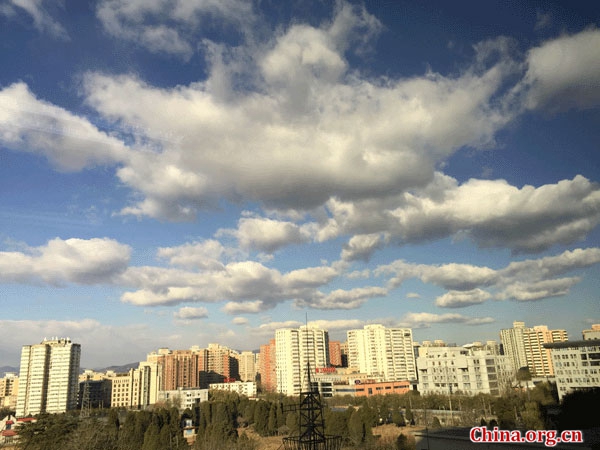Beijing's air quality sharply improved
 0 Comment(s)
0 Comment(s) Print
Print E-mail China Daily, December 22, 2017
E-mail China Daily, December 22, 2017
Beijing residents, used to seeing smoggy winter days, have enjoyed what have been called amazing days free of pollution, for 80 percent of the time in November. The blue sky has continued, data from the top environment authority showed on Thursday.

Data released by the Ministry of Environmental Protection on Thursday shows that Beijing's air quality improved sharply in November, with the average PM2.5 concentration count cut by 54 percent to 46 micrograms per cubic meter, almost the summertime level in the capital.
The air quality index stood at less than 100 on 80 percent of days in November. A year earlier, just 43 percent of days had an air quality index below 100.
In addition, air quality improved in the larger Beijing-Tianjin-Hebei region in November, with more days of good air quality, Liu Zhiquan, head of the ministry's Environment Monitoring Department, said on Thursday.
It's highly possible that Beijing will meet the ambitious reduction target set by the State Council in 2013, Environmental Protection Minister Li Ganjie said in early December, adding that the improvement showed comprehensive joint efforts are working.
The northern region has a greater chance of days with severe air pollution due to excessive emissions from heating plants during the winter, especially on windless days, the ministry has said in the past.
During past winters, the region has experienced soaring emissions of airborne pollutants, with a seasonal average increase of 30 percent, according to the ministry.
But at least two straight weeks in December through Thursday of blue skies in the capital indicate good air quality, ministry data show.
"The air quality improvement in November in Beijing and its neighboring regions is closely tied to frequent cold fronts with strong wind that blew away the pollutants in the region," Ai Wanxiu, chief expert at the National Climate Center, said recently.
Seven separate cold fronts swept the northern region in November, she said, hitting a record for the month dating to 1961.
In addition, the significant improvement showed the ongoing mix of strict pollution controls have worked, a more important reason for the clean air, Xie Hongxing, director of the Innovation Centre for Clean-Air Solutions, an environmental think tank in Beijing, said on Thursday.
China has launched comprehensive measures to reduce polluting emissions in the northern region, including restricting industrial production by shutting down thousands of polluting plants and suspending the work of iron and steel plants in 28 major cities, limiting the use of vehicles and reducing coal consumption as a heating source since September.
"The mix of efficient controls and the better implementation of them are major reasons for the improvement," Xie said, adding that the advanced technologies adopted also fueled the improvement.
For example, the ultra-low-emission technologies used in coal-fired power plants managed to reduce the emissions, and the emission standards on vehicle exhausts are stricter than many Western countries, said Xie, adding that many foreign experts from the US and UK agreed it at the recent forum.






Go to Forum >>0 Comment(s)